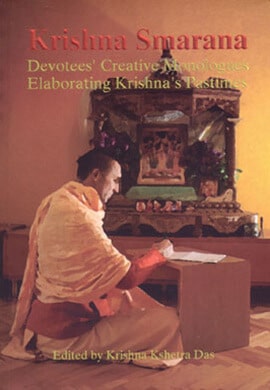An invocation (by Krishna Kshetra Swami): We, the contributors to this collection of writings, begin by offering most respectful obeisance unto the previous and present Vaishnava acharyas, beginning with our beloved preceptor, His Divine Grace A. C. Bhaktivedanta Swami Prabhupada. Through the unlimited expanse of Shrila Prabhupada’s heart’s desire to bring “Krishna consciousness” to the world – thus drawing us into the wondrous world of Krishna and his divine abode of unlimited, joyful, and perfectly spiritual play (lila) – it has become possible for us to try, in our own very limited ways, to participate in the Lord’s glorification with these “monologues.”
The idea for this collection came during the 2010 Vaishnava summer retreats in Croatia and Serbia, when I conducted a seminar in which we focused on a few selected pastimes of Krishna outside Vrindavan, as described in the Shrimad Bhagavatam. It has long been an interest of mine to explore how “creativity” might be encouraged and practiced among Vaishnavas, recognizing that we all have an expressive propensity that is the source of great energy, enthusiasm, and spiritual insight. So on these two occasions I urged devotees to do some “homework” for the seminar by making some short writing exercises, in which they were to identify one or another associate of Krishna from whom we do not hear directly in the Bhagavatam’s pages, and then “give voice” to that associate.
We think of this small book as a sort of “collective kadaca” – a notebook of our responses to what we hear and read of Krishna’s acts. Though we are so distant from the pure vision of Krishna and his lila as experienced and participated in by his intimate associates, we feel encouraged and impelled to make little, if halting, steps toward such vision through the proper ninefold practice of bhakti. In this context we see our writings contained here specifically as an expression of kirtanam – glorification – as well as of vandanam – offering of prayer.
Further, we regard them as our own personal “scripts” that may be used in our practice of arcanam – worship – in the form of manasa-puja – worship in the mind. And we feel prompted to this understanding by Shrila Prabhupada, who in a lecture commented,
You can imagine that “In my heart I have placed now a very diamond throne, and Krishna is sitting.” That is accepted. It is... Actually it becomes. Even within the mind you think that “I have kept one diamond throne, very costly throne, because Krishna is coming. He will sit down here,” that is not false. That is a fact. So you create such situation within your heart. “Now Krishna has seated. Let me wash His feet with the Ganges water, Yamuna water. (BhP 1.13.10 lecture, June 1, 1974, in Geneva)
Much deserves to be said about the relationship of imagination and devotional service, as well as of “creative writing” as devotional service. Suffice to note here simply that in the quoted lecture Shrila Prabhupada does not place truth and imagination in opposition. Rather, he says, “You can imagine . . . that is not false. That is fact. So you create such situation within your heart.” We make no claims to the “reality” or “truth” of the speeches composed here, beyond the simple truth that they show our responses to what we hear and read of Krishna’s pastimes. Perhaps literary scholars would refer to our writing attempts as some sort of “phenomenon” interpretable in terms of “reader response theory,” and that is just as well, though we have no pretensions about their literary merits. It might also be said that these writings tell more about us, the authors, than about Krishna’s divine sports with his associates. Also just as well, though we believe that our individual and collective years engaged in sincere practice of bhakti, following our spiritual preceptors, counts for much in the way of allowing us to make these experiments in connecting with Krishna lila.
